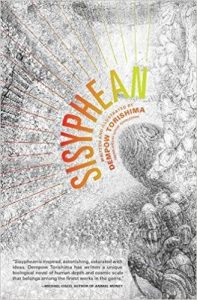 translated by Daniel Huddleston
translated by Daniel Huddleston
March 20, 2018
304 pages
I’ve seen this book described as bio-horror and New Weird and post-apocalyptic horror…and it is all of these things and more. This is one of those books that, while not exactly long (just over 300 pages), takes an oddly long time to read, mostly because of the complexity and density of each page. Dempow Torishima won the Sogen SF Short Story Award for an earlier incarnation, also called “Sisyphean” (Kaikin no to) in 2011, and his series of stories set in the same universe has won awards in Japan. And let me say up front that I am in awe of translator Daniel Huddleston’s ability to transform this mind-bogglingly strange story about human evolution and genetic engineering into an immensely readable work in English.
Here’s Haikasoru’s synopsis, which boils the novel down to its essentials pretty well: “A strange journey into the far future of genetic engineering, and working life. After centuries of tinkering, many human bodies only have a casual similarity to what we now know, but both work and school continue apace. Will the enigmatic sad sack known only as “the worker” survive the day? Will the young student Hanishibe get his questions about the biological future of humanity answered, or will he have to transfer to the department of theology? Will Umari and her master ever comprehend the secrets of nanodust?”
Let me assure you that that synopsis is just the nano-tip of a gargantuan iceberg. Sisyphean begins with what I understand as a kind of origin story, in which a seed ship, launched from a dying(?) world, is picked up by alien life-forms that attempt to study it. In the process,
it was learned that the seedship’s world of origin was a bizarre collective life-form completely covered in the same sort of nanomachines–in a state of delerium, it was groping around blindly through every nearby star system. Planning for its wholesale affirmation was begun.
Does “affirmation” mean “activation,” as in, the alien intelligence that is studying the seedship is going to “plant the seeds” in a new world(s) and see what happens?
Following this short Fragment are four sections, which are separated by other similarly-mystifying ones. Each section can stand alone and tells the story of a different character, be it a worker literally piecing together a “human” body, to a young woman traveling with a caravan across the Vastsea. The thread that runs through each of these stories is the issue of evolution, and its companion issue: heresy.
If we read each section as a window into succeeding generations, or as the various experiences of actualized lifeforms, we see that each community struggles with telling the story of its origins and development. For instance, Hanishibe, in the second section (“Cavumville (or, The City in the Hollow)”), becomes a “court enforcer,” whose first assignment is to “bring in for inquisition the astronomer Kubutsutsui, who had stirred up the people by promoting the Theory of Celestial Motion, a theory which rocked the very foundations of Shinto.” In the third section (“Castellum Natatorius (or, The Castle in the Mudsea)”), the main character talks about people being uncomfortable with the proxy of Archlearner Maruba’s “precious Speciation Hypothesis, [in which] he had promptly declared namas-machina to be an anthropoid species and claimed that any and all use of them as food was illegal. It was a rather unrealistic assertion.” And yet, the beings in this story struggle with situations that they cannot explain (like the bubbling-up or raining-down of countless bloody organs and pieces of flesh), or the momentous discovery of anthropoid life forms in a remote area that contradicts the theory that the present beings are descended from “gloambugs.” Each struggle between established ideas and new theories is just another version of the same argument, one that we humans have been discussion and arguing about for generations and centuries. Telling the story of one’s species is key to understanding its past and future, but new information/discoveries/ideas that unsettle the accepted story make those in authority fear for their power.
Against the backdrop of this repeated struggle are the recurring words and characters that appear in each section, suggesting a connection across the book that mimics the connections across time and space among the beings that were actualized from the seedships. Perhaps?
There is so much more to this book than I’ve been able to articulate here, and I think I might have a better understanding of it if I read it two or three more times in quick succession (but time, alas). Dempow Torishima’s detailed and almost tangible descriptions of muscle tissue, sections of the brain, strange new anthropoid forms, and the twists and turns of evolution make me think of Stanislaw Lem’s Eden and one particular story in The Star Diaries about humans becoming bored with their bipedal form and experimenting with bizarre consequences. I hope more of this author’s work is translated into English, and I hope that you all read Sisyphean– in part because I want to discuss it with you and try to understand it better. So get this book on March 20 and get reading!!
